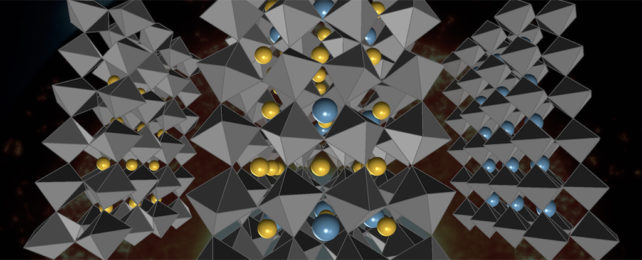Peering down through the layers that make up Earth – the crust, the upper mantle, the lower mantle, and the core – is no easy task. After all, it's not as if there's a cross-section of the planet readily available for study.
Now scientists think they have discovered a new mineral in the lower mantle, a section that makes up 55 percent of the total volume of Earth.
We already know about the layer's three main minerals – bridgmanite, ferropericlase and davemaoite – but there could well be another. What has puzzled researchers for some time is bridgmanite and davemaoite should theoretically merge together at high temperatures, thanks to their similar crystalline arrangements (technically known as a perovskite structure).
However, previous experiments haven't shown this to be the case.
"Why do davemaoite and bridgmanite not merge into one despite the fact that they have very similar atomic-scale structures? This question has fascinated researchers over two decades," says geoscientist Dan (Sang-Heon) Shim from Arizona State University.
"Many attempts have been made to find conditions where these two minerals merge, yet the answer from experiments has been consistently two separate minerals. This is where we felt we needed some fresh new ideas in experiments."
Through a series of high-pressure heating experiments in a special chamber, the researchers attempted to simulate the conditions throughout the lower mantle. Crucially, they increased temperatures very quickly, reaching around 1,650 to 1,925 degrees Celsius (3,000 to 3,500 degrees Fahrenheit) in less than a second, before rising to temperatures of around 2,800 degrees Celsius.
The small, heated samples – now at temperatures representative of the topmost layer of the lower mantle down to the deep lower mantle – were then observed through X-ray imaging to map the structure of its minerals. Unexpectedly, at temperatures approaching 2,000 degrees Celsius and above, a single perovskite mineral was shown to form, a combination of both davemaoite and bridgmanite.
This points to the deeper part of the lower mantle having a different mineralogy mix to the section higher up, because of the greater temperature and pressure. A merging of bridgmanite and davemaoite lower down would add an extra mineral to consider, and the researchers think that iron probably plays an important role.
"It has been believed that a large size difference between calcium and magnesium, the major cations of davemaoite and bridgmanite, respectively, should hinder these two minerals from merging," says mineralogist Byeongkwan Ko from Michigan State University.
"But our study shows that they can overcome such difference in hot environments."
Earth's mantle was previously much hotter than it is today, which suggests that perovskite mineral merging would have been more prevalent – and therefore that the geological composition has been altered significantly over time.
These findings match up with previous research suggesting that the properties of the lower mantle change the deeper it goes. This is something that future studies will be able to analyze further – both in terms of its current state and its state in the past.
"Our finding requires revision of the deep-mantle mineralogy models and will have an impact on our understanding of the composition, structure, dynamics, and evolution of the region," write the researchers in their published paper.
The research has been published in Nature.
